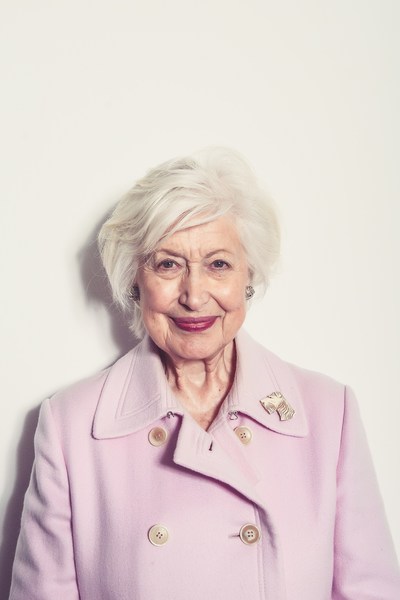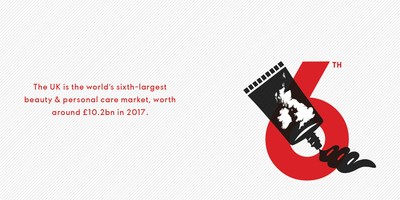LONDON, Oct. 22, 2018 /PRNewswire/ -- While times may be tough on the High Street, UK Beauty is outperforming other sectors of retail, posting sales increases of 18% among premium department stores and 9% among traditional specialist retailers between 2015-2017. These were some of the findings of a report comprehensively mapping the size and scope of the UK Beauty Industry, commissioned by CEW UK, the leading beauty organisation.
While 1 in 3 UK consumers are shopping online for beauty, spending an estimated £1.1bn, the CEW report revealed sales in specialist retailers (such as Boots, Superdrug, The Body Shop) increased from £3.4bn to £3.7bn from 2015-2017. Over the same period, beauty sales through department stores rose from £1.7bn to £2bn, as consumers sought out prestige beauty brands on the high street.
Caroline Neville MBE, President of CEW commented "Beauty appears to be more resilient than other sectors on the High Street. Bricks and mortar retailing is still crucial to beauty and the primary medium for consumers to interact and purchase brands." She added, "UK Beauty is celebrated across the globe for its creative, entrepreneurial spirit and consistently produces enduring iconic brands. The sector's continual success lies in an ability to innovate, stay relevant and be exciting. This is reflected in our performance in what is one of the toughest trading periods in decades for the High Street."
"By working with Mintel to deliver this report, we wanted to clearly demonstrate the success of the UK Beauty Industry, at home and around the world, and map in detail the demographics and scale of the sector," Caroline said. Mintel are recognised in the beauty industry as the leading market intelligence agency and examined key factors attributed to spending, employment, the success and future of the UK Beauty Industry.
The report found that in 2017, UK consumers spent £25.1bn on beauty, with this figure set to rise to £26.9bn by 2022. While beauty lags behind British Fashion's contribution of £32bn to the country's GDP, due largely to higher unit retail prices, over one million people are employed in the UK Beauty Industry compared to the 890,000 working in the fashion sector.
"The UK beauty and personal care industry has quickly taken advantage of advancements in digital technology and the consumer thirst for new products. Countless men and women have set up their own beauty businesses – exploiting cross border sales, increasingly penetrating new markets and we wanted to map that success," said Jane Henderson, Global President of Beauty and Personal Care, Mintel.
Other key findings of the CEW Report include:
- The beauty industry is split into four market categories; Beauty Products and Personal Care Products, which each command a 20% share. Spa, Salon and In-store Treatment Services, which commands a 30% share of total spend and Hairdressing and Barbershop Services, which also commands a 30% share.
- The UK is the world's sixth-largest market for beauty and personal care, worth around £10.2bn in 2017. Per capita spend on beauty and personal care products in the UK was £155 in 2017, the fifth highest in the world.
- Almost 1,700 companies operated in the UK beauty and personal care market from 2015-17, launching around 40,000 unique products, under 1,800 different brands.
- Consumer expenditure on spa, salon and in-store beauty treatments is estimated to reach £7.57bn in 2017.
- The total value of the UK Fragrance market was £1.8bn in 2017, while £1.98bn was the total value of the UK Colour Cosmetics market for that year.
- 24% of UK consumers, who visited an airport in the last year, bought products while they were there, spending £650m on Tax Free Beauty.
- Consumer expenditure on in-salon hair services increased by 3% in 2017, to £7.4bn.
- Consumer expenditure on spa, salon and in-store beauty treatments reached £7.57bn in 2017.
- In April-June 2017, total employment in 'Beauticians and related occupations' saw a massive 40% increase from the same period in 2016. This is partly driven by the technology allowing at home beauty treatments and a growth in spa and hair salons.
- The UK has over 50,000 locations offering beauty services; 35,704 hair salons, 2,967 specialist barbershops, 302 specialist hair salons, 13,107 beauty salons and 1,512 specialist nail bars/technicians.
- Post Brexit, sales of beauty and personal care products continue to rise providing further evidence of 'The Lipstick Effect' – during periods of economic downturn, consumers tend to purchase more 'little luxuries', such as lipstick, treatments and cosmetics.
About CEW:
Founded in 1992, Cosmetic Executive Women is a not-for-profit professional organisation with more than 1,000 members in the United Kingdom, from the beauty industry and related fields. We bring the beauty community together, at every stage of their careers, from every facet of the industry. In the UK, CEW has grown to become the most influential organisation, promoting and defining the British Beauty Industry, and has for the last quarter of a century worked to reach a pre-eminent position as the only voice of the UK beauty industry.
About MINTEL:
Mintel is the world's leading market intelligence agency. For over 40 years, Mintel's expert analysis of the highest quality data and market research has directly impacted on client success. With offices in London, Chicago, Shanghai, Belfast, Düsseldorf, Kuala Lumpur, Mumbai, Munich, New York, São Paulo, Seoul, Singapore, Sydney, Tokyo, and Toronto, Mintel has forged a unique reputation as a world-renowned business brand. For more information on Mintel, please visit www.mintel.com.
Photo - https://mma.prnewswire.com/media/772179/CEW_Caroline_Neville.jpg
Photo - https://mma.prnewswire.com/media/772180/CEW_UK_personal_care_market.jpg
Logo - https://mma.prnewswire.com/media/703458/CEW_Logo.jpg


Share this article